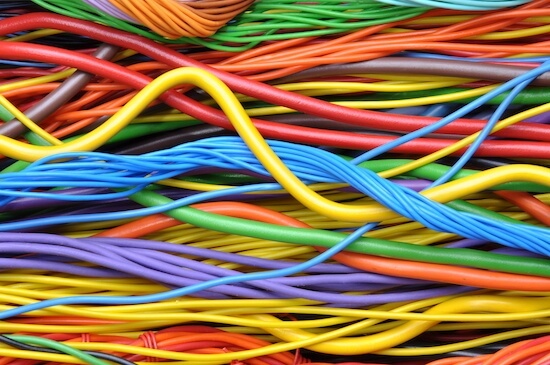What’s the Difference Between Wire and Cable?

There are fundamental differences between wires, conductors, and cables that determine when and how they are used. Being able to understand and clearly explain the differences can make planning an electrical installation job easier. To avoid confusion, we will focus on terminology related to uses in the electrical contracting industry.
What is Wire?
A wire is a single conductor, typically made of copper, aluminum, or sometimes steel (non – electrical use). The two main types of wire are solid and stranded.
Solid wire is made of one single strand of drawn copper, aluminum or other conductive metal into a long thin, still stiff, but bendable string like form. Solid wire has less resistance, so it is often used in applications that call for handling higher frequencies.
Stranded wire is comprised of multiple strands of solid wire drawn into ultra thin and flexible thread like filaments that can be twisted or braided together to form a single conductor comparable in size and weight to their solid counterparts. Stranded wire is often coated and is ideal for jobs that require more flexibility.
Conductor
Conductor is a term for wire or wire filaments that are not separated by coating or insulation. For instance, the twisted or braided strands of wire that make up stranded wire make up a single stranded conductor, once the appropriate jacket has been applied. As does the single solid wire strand once it has been jacketed. Single conductors can run smaller than 22 AWG and as large as the wires in the MCM classifications. They can consist of a single piece of wire or multiple strands of ultra thin wire (filaments), as long as every strand of wire is uninsulated and in contact with the other wires.
Cable
When trying to define a cable the first thing one should always remember is that wire is a component of a cable. Cables are groups of two or more conductors made up of stranded or solid wire that are twisted, wrapped or otherwise bound together in some way. There are four main cable types:
Twisted pair cable: two cables that are twisted together. Twisted pair cables are often used in telecommunications industries, professional sound engineering, studios, theaters and intercom systems.
Multi-conductor cable: multiple cables grouped together and insulated from each other. The insulation reduces interference between the cables, which makes multi-conductor cables a popular choice for use in data transmission. Run together as a Quik-Pull bundled cable, they are ideal for running lighting, control and power circuits in the OEM market space and electrical construction industries.
Coaxial cable: constructed with a solid inner conductor and a surrounding outer layer foil conductor. The two layers are insulated from each other. These cables are usually used in the broadcast medias of television, radio and other forms of communication. Coaxial cable is slowly falling out of favor as multiconductor category/ethernet cables and fiber optic prices have come down in price and advanced the ability to transmit signals with less and less interruptions.
Fiber-optic cable: a grouping of wires that includes or is made entirely of optical fibers. Optical fibers are hair-thin wires made from glass or plastic that can carry more data faster than alloy cables. Fiber optics are the new wave of transmitting data, and communications but cannot replace copper cables all together because they cannot transmit power.
All of these types of cables may themselves be bundled to form a new Quik-Pull type of cable bundle for installation purposes.
Wire vs. Conductor vs. Cable
To wrap up, remember you cannot have a cable without conductors and conductors are made up of individual wire strands. The wire can be one thicker strand for a solid wire or finer strands (filaments), and a conductor can consist of a single strand of wire, to multiple strands, as long as, the multiple strands are not insulated from each other. And a cable is made of more than one conductor, and each conductor has to be insulated from the others.
Want to learn more about the differences between bundled cable configurations? Have a look at this article.

READY TO SAVE TIME & MONEY WITH BUNDLED CABLE?
Get a quote on our custom cable bundles today.


